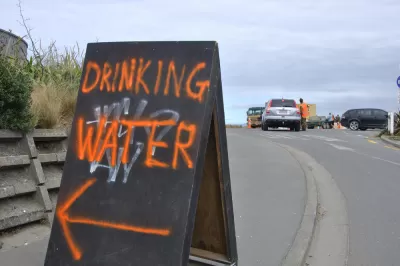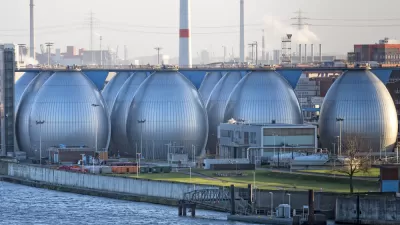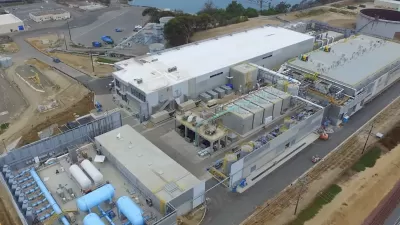In this radio report on the use of the expensive, controversial strategy of desalination to meet California's water needs in an epic drought, KQED's science reporter speaks with the mayor of Carmel, a V.P. of Poseidon Water, and an environmentalist.

Mayor Tom Burnett of Carmel-By-The-Sea, California finds himself in an unusual position. "Not only are his parents marine biologists, but his grandfather David Packard's Silicon Valley fortune laid the foundation for the Monterey Bay Aquarium," writes KQED science reporter Daniel Potter. [Listen here.] "Burnett himself used to work on climate rules for the EPA."
"It's quite expensive. It has a large carbon footprint. And there's real concerns about impact on marine life," he states. "So here I am, advocating a project that has a large carbon footprint and, if not done correctly, can hurt the oceans."
The Monterey Peninsula Water Supply Project (MPWSP) "will consist of a desalination plant, slant intake wells [for drawing seawater from underground rather than the water], pipelines for brackish water, pipelines for brine disposal, and production water delivery pipes, and is currently under construction," according to the project summary wiki. See Jan. 1 project newsletter [PDF].
Carmel was hit with a "cease-and-desist order to protect the Carmel River, the area's main source of drinking water for decades, forcing the surrounding towns to look for water somewhere else," states Potter.
"For us, desal really was the last option to consider," Burnett states. "But we got to that point."
Burnett is not only concerned with the large energy costs associated with reverse osmosis used to remove the salt from seawater but the environmental ones, "from the fish eggs that facilities can kill when they suck water in [although that is avoided by the MPWSP's slant wells] to what happens when they dump all the leftover salt back out to sea [also avoided, claims project builder California-American Water Company]," states Potter.
And then there's the carbon footprint, as Mayor Burnett indicated. Ironically, advocates use climate change as the reason why more regions in the state need to consider building desalination plants due to its effect on the state's traditional water supply, the Sierra snowpack.
"(T)he larger concern is climate change and what happens 10 years and 20 years from now," states Scott Maloni, vice president of Poseidon Water." Poseidon is building the country's biggest desalination plant in Carlsbad. "Can we really count on the Colorado River or Northern California to continue to supply the vast majority of the state's population with water?" asks Maloni.
Environmentalist Susan Jordan, with the California Coastal Protection Network sees desalination as enabling more unsustainable growth.
If you're going to do something like desal, you want to make sure that you're doing everything you can in terms of conservation, water recycling, water reuse. And you don't want to fuel unsustainable development that just perpetuates your problem.
Jordan's points appear to largely coincides with those made by Eduardo Porter, Economic Scene columnist for The New York Times made here earlier this month.
FULL STORY: Desalination Plants: Drought Cure Or Growth Enabler?

Alabama: Trump Terminates Settlements for Black Communities Harmed By Raw Sewage
Trump deemed the landmark civil rights agreement “illegal DEI and environmental justice policy.”

Study: Maui’s Plan to Convert Vacation Rentals to Long-Term Housing Could Cause Nearly $1 Billion Economic Loss
The plan would reduce visitor accommodation by 25% resulting in 1,900 jobs lost.

Why Should We Subsidize Public Transportation?
Many public transit agencies face financial stress due to rising costs, declining fare revenue, and declining subsidies. Transit advocates must provide a strong business case for increasing public transit funding.

Paris Bike Boom Leads to Steep Drop in Air Pollution
The French city’s air quality has improved dramatically in the past 20 years, coinciding with a growth in cycling.

Why Housing Costs More to Build in California Than in Texas
Hard costs like labor and materials combined with ‘soft’ costs such as permitting make building in the San Francisco Bay Area almost three times as costly as in Texas cities.

San Diego County Sees a Rise in Urban Coyotes
San Diego County experiences a rise in urban coyotes, as sightings become prevalent throughout its urban neighbourhoods and surrounding areas.
Urban Design for Planners 1: Software Tools
This six-course series explores essential urban design concepts using open source software and equips planners with the tools they need to participate fully in the urban design process.
Planning for Universal Design
Learn the tools for implementing Universal Design in planning regulations.
Smith Gee Studio
Alamo Area Metropolitan Planning Organization
City of Santa Clarita
Institute for Housing and Urban Development Studies (IHS)
City of Grandview
Harvard GSD Executive Education
Toledo-Lucas County Plan Commissions
Salt Lake City
NYU Wagner Graduate School of Public Service




























